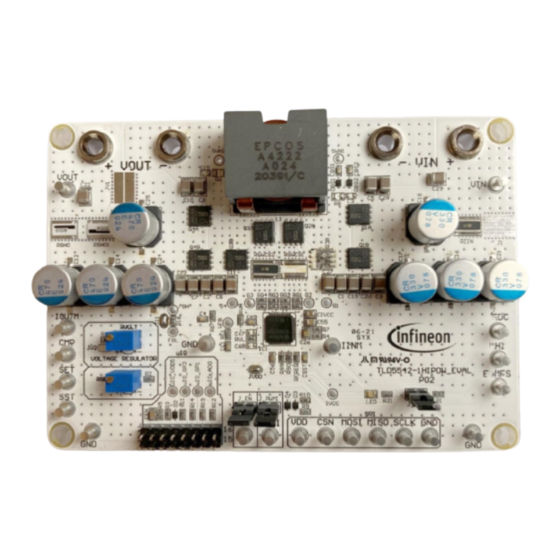
Table of Contents
Advertisement
Quick Links
UM TLD5542-1 eval
TLD5542-1 Multichannel evalboard V4.5
User Manual
About this document
Product description
TLD5542-1QV: H-Bridge buck-boost DC/DC controller designed for high power, high efficiency automotive
applications
• Constant current (LED) and constant voltage regulation
• SPI for diagnostics and control
• Limp Home function (fail-safe mode)
• EMC optimized device: Spread Spectrum
Scope and purpose
Scope of this user manual is to provide to the audience instructions on usage of the TLD5542-1 Multichannel
evalboard V4.4 and relative PC GUI.
The TLD5542-1 Multichannel evalboard V4.4 it is an evaluation platform for the TLD5542-1, which can drive 3 LED
functions (HB, LB, DRL), with a single efficient DC/DC converter. The board shows good EMC performance, EMC
report available for download on the evaluation board webpage.
Intended audience
Hardware engineers, software engineers, system architects
User Manual
Please read the Important Notice and Warnings at the end of this document
Rev.1.12
www.infineon.com
page 1 of 17
2020-04-02
Advertisement
Table of Contents

Summary of Contents for Infineon TLD5542-1
-
Page 1: About This Document
• EMC optimized device: Spread Spectrum Scope and purpose Scope of this user manual is to provide to the audience instructions on usage of the TLD5542-1 Multichannel evalboard V4.4 and relative PC GUI. The TLD5542-1 Multichannel evalboard V4.4 it is an evaluation platform for the TLD5542-1, which can drive 3 LED functions (HB, LB, DRL), with a single efficient DC/DC converter. -
Page 2: Table Of Contents
TLD5542-1 Multichannel evalboard V4.5 User Manual Table of contents Table of contents About this document ......................... 1 Table of contents ........................2 Glossary ..........................3 Description ..........................4 Quick start procedure ....................... 5 Possible light scenarios ......................8 Operating range and power derating ..................9 Electrical characteristics ......................10... -
Page 3: Glossary
TLD5542-1 Multichannel evalboard V4.5 User Manual Glossary DRL: Daytime Running Light function POS: position light obtained by dimming down the DRL function LB: Low Beam function HB: High Beam function H-Bridge: 4 switches topology buck-boost DC/DC converter (see Figure 1) -
Page 4: Description
User Manual Description The TLD5542-1 multichannel evalboard V4.4 it is an evaluation platform for the TLD5542-1, which can drive 3 LED functions (HB, LB, DRL), with a single efficient DC/DC converter. In the single DC/DC multichannel system night-time functions (e.g. HB and LB) are connected in series and the complementary daytime (DRL) function in parallel by mean of switches (Figure 2). -
Page 5: Quick Start Procedure
Load will be powered with Default configuration: LB 1000 mA, HB 800 mA , POS 28 mA (400 mA @ 7%) In order to control the TLD5542-1 Multichannel evalboard, install the GUI V1.0 to the control PC (chapter Error! Reference source not found.) - Page 6 TLD5542-1 Multichannel evalboard V4.5 User Manual Connect a micro USB cable from the TLD5542-1 evalboard to the PC (Figure 6) Figure 6 Connect a microUSB cable from the PC to the evalBoard Launch the “TLD5542-1_MULTICH_GUI_V1.0.xlsm” to execute the excel GUI ( Figure 7 ) Figure 7 TLD5542-1 Excel GUI V1.0 screenshot on communication established...
- Page 7 LB current = 1.14 A @88% duty=> 1A avg POS = 300 mA @ 7% duty Figure 8 Time sharing and duty cycle losses For further information please read the TLD5542-1 cost optimized application note and SW description documents: Infineon-Z8F67062262_Cost_Optimized_TLD5542-AN.pdf Infineon-Z8F64914635_TLD5542-1_Software_Description-AN.pdf User Manual 7 of 17 Rev.1.12...
-
Page 8: Possible Light Scenarios
(28 mA = 400 mA@7%) By pressing Limp Home button on the evalboard, LHI pin of the TLD5542-1 is activated, and the bypass switches are configured by a dedicated circuitry in order to power LB only @ 850 mA. The μC SPI commands and GPIOs are ignored, simulating a fail-safe operation. -
Page 9: Operating Range And Power Derating
TLD5542-1 Multichannel evalboard V4.5 User Manual Operating range and power derating Software power derating is implemented on SW 3.8, and it reduces output current (and thus the output power) when the battery voltage drops below 9V at the board connector. Power derating profile is set as shown in Figure 9 (6W/V). -
Page 10: Electrical Characteristics
TLD5542-1 Multichannel evalboard V4.5 User Manual Electrical characteristics Table 2 TLD5542-1 multichannel evalboard V4.4 – electrical characteristics Value Parameter Symbol Unit Note/Test Condition Min Typ Max (Normal) Input Voltage – ˜ (Extended) (Survival) Out voltage – – scenario = LB/HB only POS = OFF –... -
Page 11: Diagnostic
TLD5542-1 Multichannel evalboard V4.5 User Manual Diagnostic TLD5542-1 multichannel software version 4.0 (or higher) is able to detect several failures on the LED load: Table 3 Failure detection Failure type Description Open FA2 open is always reported as FA2 & FA3 open due to schematic... -
Page 12: Pcb Layout
TLD5542-1 Multichannel evalboard V4.5 User Manual 9 PCB layout Figure 12 PCB layout top view User Manual 12 of 17 Rev.1.12 2020-04-02... -
Page 13: Schematic
TLD5542-1 Multichannel evalboard V4.5 User Manual Schematic User Manual 13 of 17 Rev.1.12 2020-04-02... - Page 14 TLD5542-1 Multichannel evalboard V4.5 User Manual User Manual 14 of 17 Rev.1.12 2020-04-02...
- Page 15 TLD5542-1 Multichannel evalboard V4.5 User Manual User Manual 15 of 17 Rev.1.12 2020-04-02...
-
Page 16: Revision History
With respect to any examples, hints or any typical 81726 München, Germany values stated herein and/or any information WARNINGS regarding the application of the product, Infineon Technologies hereby disclaims any and all Due to technical requirements products may contain warranties and liabilities of any kind, including dangerous substances.















Need help?
Do you have a question about the TLD5542-1 and is the answer not in the manual?
Questions and answers